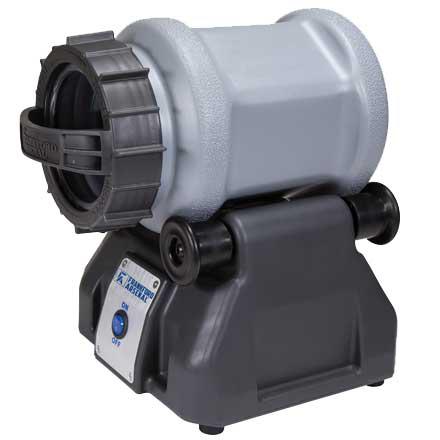Frankford Arsenal Platinum Series Rotary Tumbler LITE In the really old days, we used rotary tumblers for everything from polishing rocks to cleaning our range brass. They did a fine job except were pretty noisy and had a tendency to leak or break a belt after extensive use. And, we really used them extensively. When the vibratory tumblers arrived on the market around twenty years ago, we decided to switch. And, while they did a good job of cleaning the brass, we still had to clean the primer pockets by hand. Because, if you put de-primed brass in the tumblers, the media just never seemed to clean the pockets. Not to mention the nuisance of having to pry bits of media from the flash hole. As such, we tumbled our fired brass, deprimed them after cleaning and manually cleaned the primer pockets. A lot of extra work if you had cleaned several hundred cases in a single load. And, vibratory tumblers will quickly wear out if you overload them, which is all too common with those of us who are impatient and want to clean a lot of brass at one time. OK, that is a personal problem and our fault. However, we believe that we should be able to clean large lots of brass at once without worrying about the machine dying in the process. So, when Frankford Arsenal introduced their new premium rotary tumbler, we had to order it and give it a try. The first thing we noticed about this new tumbler was the heavy polymer construction of the drum. The end cap is made from a similar polymer.. Unlike most rotary tumblers, which have a gasket or O-ring inside the end cap, this unit utilizes a separate sealing insert with a thick gasket to insure a water-tight seal. It even allows you to look inside to monitor the progress of the tumbling. The
two drive wheels on the cradle are gear driven. No belts to break or
wear out. The cradle's design is such, that once positioned, the
drum remains in place throughout the cleaning process. You never
have to worry about it going off center or becoming unbalanced.
However, the unit should be operated on a hard, flat surface. Not
elevated or on carpet. Frankford Arsenal recommends a two step cleaning process. Not only to clean the brass, but to reduce the wear and tear on your reloading dies. In the first step, they recommend tumbling brass that has not been deprimed. Use their cleaning solution, about 1 - 2 oz per load. You simply add your dirty brass, fill the drum with water to the bottom of the mouth opening, pour in the cleaning fluid, install the sealing insert with its gasket and tighten the end cap. Place the drum on the cradle and tumble for 1 - 2 hours. After tumbling, remove the cap and the sealing insert seal. Pour out the dirty solution into a bucket, rinse the brass in the drum with fresh water (we actually use a colander) and let dry on a paper towel. However, if you are not using range brass, but your own reloads, this step is probably unnecessary, as your brass is already fairly clean. Under those circumstances, we recommend going directly to step two. Now you have clean brass that when properly lubricated will not cause excessive wear on your reloading dies. After depriming and resizing the brass, repeat the above process, except add in the steel media (pins sold separately #1097884) instead of the cleaning solution. It will take about 2-3 hours and when it is finished, your brass will be nicely burnished. With all of the above being said, most readers are thinking this takes a lot of work. Granted, it is more labor intensive than vibratory tumblers, but given the time that is saved in cleaning the primer pockets and the end result, it is worth the effort for reloaders who do a lot of shooting. We don't recommend this tumbler for the casual reloader who only shoots a few dozen rounds a year to prepare for hunting season or occasional plinking. If you fall into that category, a vibratory tumbler is still your best option. However, if you are a serious shooter who burns through several thousand rounds a year for target practice, competition shooting or hunting, then this unit makes a lot of sense. It is capable of handling 150 - 200 pieces of .308 brass (300 pieces of .223) at once, without bogging down. In fact, it would be rather inefficient to tumble a few dozen cases in this drum. The one issue we had with this unit was the lack of a rubber inner liner (which the larger F.A. Rotary Tumbler has). Because of this, the steel media (pins) have a tendency to remain on the bottom of the drum as it rotates, rather than dispersing throughout the cases. The result is that primer pockets are not always compleely cleaned; but, the cases will be well burnished. Additional specifications for the LITE Tumbler are:
The instruction manual included with this machine is very user friendly. With an MSRP of $119.79, it is not for everyone. However, we have found it listed on the internet for around $90, which is competitive with high-end vibratory tumblers. |